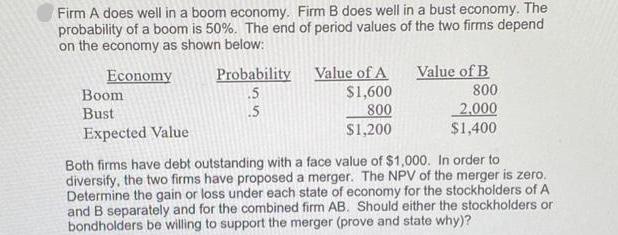Answered step by step
Verified Expert Solution
Question
1 Approved Answer
Firm A does well in a boom economy. Firm B does well in a bust economy. The probability of a boom is 50%. The

Firm A does well in a boom economy. Firm B does well in a bust economy. The probability of a boom is 50%. The end of period values of the two firms depend on the economy as shown below: Economy Probability .5 .5 Value of A $1,600 800 $1,200 Value of B 800 2,000 $1,400 Boom Bust Expected Value Both firms have debt outstanding with a face value of $1,000. In order to diversify, the two firms have proposed a merger. The NPV of the merger is zero. Determine the gain or loss under each state of economy for the stockholders of A and B separately and for the combined firm AB. Should either the stockholders or bondholders be willing to support the merger (prove and state why)?
Step by Step Solution
★★★★★
3.33 Rating (147 Votes )
There are 3 Steps involved in it
Step: 1
Lets first calculate the gain or loss for stockholders and bondholders of firms A and B separately under each state of the economy Boom and Bust Then ...
Get Instant Access to Expert-Tailored Solutions
See step-by-step solutions with expert insights and AI powered tools for academic success
Step: 2

Step: 3

Ace Your Homework with AI
Get the answers you need in no time with our AI-driven, step-by-step assistance
Get Started


